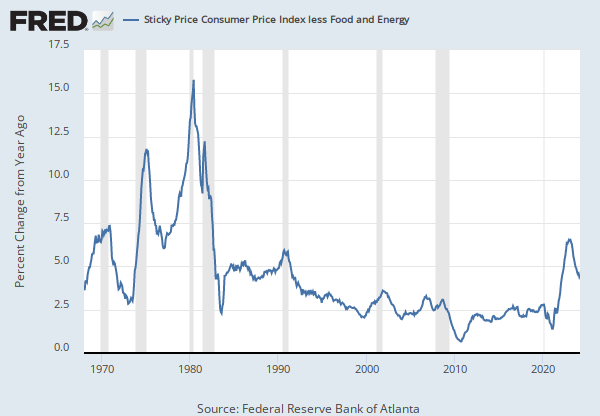Federal Reserve Economic Data
Data in this graph are copyrighted. Please review the copyright information in the series notes before sharing.
Notes
Source: U.S. Bureau of Labor Statistics
Release: Consumer Price Index
Units: Index 1982-1984=100, Not Seasonally Adjusted
Frequency: Monthly
Notes:
Handbook of Methods
Understanding the CPI: Frequently Asked Questions
Suggested Citation:
U.S. Bureau of Labor Statistics, Consumer Price Index for All Urban Consumers: All Items in U.S. City Average [CPIAUCNS], retrieved from FRED, Federal Reserve Bank of St. Louis; https://fred.stlouisfed.org/series/CPIAUCNS, .
Source: U.S. Bureau of Economic Analysis
Release: Gross Domestic Product
Units: Index 2017=100, Seasonally Adjusted
Frequency: Quarterly
Notes:
BEA Account Code: A191RA
For more information about this series, please see http://www.bea.gov/national/.
Suggested Citation:
U.S. Bureau of Economic Analysis, Real gross domestic product (chain-type quantity index) [A191RA3Q086SBEA], retrieved from FRED, Federal Reserve Bank of St. Louis; https://fred.stlouisfed.org/series/A191RA3Q086SBEA, .
Source: U.S. Bureau of Economic Analysis
Release: Gross Domestic Product
Units: Index 2017=100, Seasonally Adjusted
Frequency: Quarterly
Notes:
BEA Account Code: DGDSRA
For more information about this series, please see http://www.bea.gov/national/.
Suggested Citation:
U.S. Bureau of Economic Analysis, Real personal consumption expenditures: Goods (chain-type quantity index) [DGDSRA3Q086SBEA], retrieved from FRED, Federal Reserve Bank of St. Louis; https://fred.stlouisfed.org/series/DGDSRA3Q086SBEA, .
Source: U.S. Bureau of Economic Analysis
Release: Gross Domestic Product
Units: Index 2017=100, Seasonally Adjusted
Frequency: Quarterly
Notes:
BEA Account Code: A191RG
A Guide to the National Income and Product Accounts of the United States (NIPA) - (http://www.bea.gov/national/pdf/nipaguid.pdf)
Suggested Citation:
U.S. Bureau of Economic Analysis, Gross Domestic Product: Chain-type Price Index [GDPCTPI], retrieved from FRED, Federal Reserve Bank of St. Louis; https://fred.stlouisfed.org/series/GDPCTPI, .
Release Tables
- Table 1.1.3. Real Gross Domestic Product, Quantity Indexes: Quarterly
- Table 1.1.4. Price Indexes for Gross Domestic Product: Quarterly
- Table 1.2.3. Real Gross Domestic Product by Major Type of Product, Quantity Indexes: Quarterly
- Table 1.2.4. Price Indexes for Gross Domestic Product by Major Type of Product: Quarterly
- Table 1.3.3. Real Gross Value Added by Sector, Quantity Indexes: Quarterly
- Table 1.3.4. Price Indexes for Gross Value Added by Sector: Quarterly
- Table 1.4.3. Real Gross Domestic Product, Real Gross Domestic Purchases, and Real Final Sales to Domestic Purchasers, Quantity Indexes: Quarterly
- Table 1.4.4. Price Indexes for Gross Domestic Product, Gross Domestic Purchases, and Final Sales to Domestic Purchasers: Quarterly
- Table 1.5.3. Real Gross Domestic Product, Expanded Detail, Quantity Indexes: Quarterly
- Table 1.5.4. Price Indexes for Gross Domestic Product, Expanded Detail: Quarterly
- Table 1.6.4. Price Indexes for Gross Domestic Purchases: Quarterly
- Table 1.7.3. Real Gross Domestic Product, Real Gross National Product, and Real Net National Product, Quantity Indexes: Quarterly
- Table 1.7.4. Price Indexes for Gross Domestic Product, Gross National Product, and Net National Product: Quarterly
- Table 1.8.3. Command-Basis Real Gross Domestic Product and Gross National Product, Quantity Indexes: Quarterly
- Table 2.3.3. Real Personal Consumption Expenditures by Major Type of Product, Quantity Indexes: Quarterly
Related Data and Content
Data Suggestions Based On Your Search
Content Suggestions
Other Formats
Consumer Price Index for All Urban Consumers: All Items in U.S. City Average
Monthly, Seasonally Adjusted Semiannual, Not Seasonally AdjustedReal gross domestic product (chain-type quantity index)
Annual, Not Seasonally AdjustedReal personal consumption expenditures: Goods (chain-type quantity index)
Annual, Not Seasonally Adjusted Monthly, Seasonally AdjustedRelated Categories
Releases
Tags
Permalink/Embed
modal open, choose link customization options
Select automatic updates to the data or a static time frame. All data are subject to revision.









































